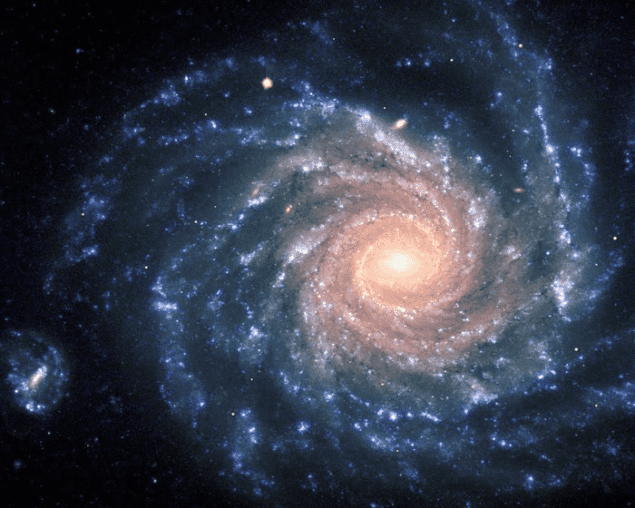
Can modified Newtonian dynamics (MOND) explain the curious behaviour of rotating galaxies? Two research groups have independently studied the dynamics of large numbers of galaxies to test MOND and have reached different conclusions. MOND is an alternative to dark matter — a hypothetical substance that is thought to affect the rotation of galaxies via its gravitational pull – and the conflicting studies could help solve problems with our current understanding of galaxy dynamics.
At first glance, Newtonian gravity appears to fail spectacularly when used to calculate the dynamics of galaxy rotation. The problem is that stars far from the galactic centre rotate much faster than predicted and should be flung away from the galaxy. The conventional explanation is that enormous quantities of cold dark matter (CDM) provides additional gravitational glue that binds the galaxies together. This, however, gives physicists the task of explaining the nature of dark matter – which despite its apparent abundance, has never been detected directly.
A minority of physicists, however, take the opposite approach and call for a revision of Newton’s laws. Extraordinary as this suggestion sounds, it does offer potential solutions to some otherwise troubling problems in galactic dynamics.
Curious correlations
Despite being a pillar of the Standard Model of cosmology, CDM does not offer a complete explanation for the observed dynamics of galaxies. In 2016, for example, Federico Lelli of Case Western Reserve University in the US and colleagues studied a sample of 175 galaxies. They looked at the rotation rate at different distances from the centre of each galaxy. They calculated that the radial acceleration at an arbitrary point in each galaxy is correlated with the amount of visible matter attracting it – but the relationship does not match that predicted by Newtonian dynamics.
The CDM model explains this discrepancy by assuming the visible matter is attracted by dark matter as well as other visible matter. However, dark matter could be found in different quantities and different places in different galaxies, so this relationship should have quite a lot of scatter. A mathematically predictable deviation from the predictions of Newtonian dynamics is hard to explain under the CDM model.
MOND, however, proposes that, at very large radii and small accelerations, gravity decays with distance more slowly than Newton’s inverse square law. This removes the need for dark matter, providing a clear explanation for the tight non-Newtonian correlation between visible matter and radial acceleration.
Universal scale
In one of the new studies, Davi Rodrigues of Federal University of Espírito Santo in Brazil and colleagues examine 193 disk galaxies (most of which had previously been studied by Lelli) to see whether there is a fundamental acceleration scale. This would be a universal scale factor relating the predictions of Newtonian dynamics and MOND.
“We do a full Bayesian [statistical] analysis in order to find the error bars of this radial acceleration relation for each galaxy,” explains Rodrigues. Having done this, the researchers conclude that there is no scale factor that is not ruled out at a statistical significance of at least 10σ – which means that it is extremely unlikely that the finding is a result of statistical fluctuations in the data.
The researchers therefore rule out any fundamental theory that extends MOND without amending its underlying dynamics. Instead, they suggest that the apparent correlation between visible matter and galactic dynamics could arise from hypothetical complex interactions between visible matter and dark matter.
Working independently, Lelli and colleagues address the same question using different statistical techniques. The researchers fit the radial acceleration relation to data from their set of 175 galaxies. They calculate a value for the scatter in the data that is much lower than the value arrived at by Rodrigues.
Plane uncertainty
Lelli’s group argue that the other study has ignored the uncertainty in the plane of inclination of disk galaxies relative to the angle of observation – which is an additional source of error in their calculations. Furthermore, says Lelli – now at the European Southern Observatory in Germany – his team found that allowing the scale factor to vary from galaxy to galaxy did not improve the fit. Therefore, the researchers suggest, the observed scatter in the data is better explained by observational errors than by an underlying inconsistency between the data and the fundamental acceleration scale predicted by MOND.
James Binney of the University of Oxford notes that the Rodrigues group’s paper does not question Lelli and colleagues’ 2016 conclusion that there is a mathematically predictable relationship within galaxies between the visible matter and the radial acceleration. Whether that relationship can be fitted by a single parameter that applies to all galaxies is, he says, “subsidiary”.
Rogrigues and colleagues describe their work in Nature Astronomy. Lelli’s team will publish its results in Astronomy & Astrophysics and a preprint is available on arXiv.



